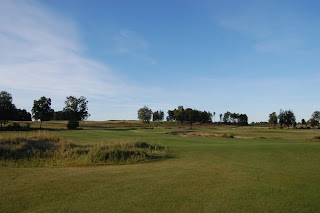Just to be on record, Sand Valley is not a "Links Course" or an imitation links. Elements from the links have been stolen, that is for sure, but what was taken from the links is the heart and soul. Not the aesthetics.
Honestly, I cannot tell you what type of golf course Sand Valley is. She is schizophrenic. Has multiple personalities. There are holes through forest, in open rolling spaces, along the river, paralleling the rail line, holes with wetlands, with ravines, along ledges, in an abandoned quarry, and through river dunes.
You tell me... anything but Links... please.
Is she modern?
Is she classic?
It will be interesting to hear the opinions.
The following format is from another course I had designed and was written about in 2000, it has been adapted for Sand Valley because it fits here too:
Links Golf? Scottish Golf?
This course is not meant to be a Links-type course. To call it one would be a severe misrepresentation of fact, as most courses marketed as Links-type are.
This course is designed in the spirit of those timeless inland designs from the Golden Age commonly found in America, Canada, England and Australia. Like the Golden Age designs and architects, elements and ideas were adapted from Links Golf; the heart and soul, but not the cosmetics. Modern construction equipment has allowed us to take some liberties in land alteration at Sand Valley that wasn't so easily executed 70-years ago, but the ideas we stole from Links golf are:
1.
Wide Fairways. This allows all classes of golfers to enjoy the game, and if the course is hard, fast and windy, the most interesting conditions to play golf, there is room to play. It allows for a whole spectrum of strategies, and as the hole location changes, firmness of ground changes, wind changes direction... often the case at Sand Valley, as there is no prevailing wind, the line of attack changes too. This keeps the game interesting... ideally mystical for years to come.
2.
Random, natural bunkering. Placing bunkers for "better players" looks artificial, is a modern occurence and sucks the fun and interest out of the game for many. Ours eat into the fairways, and as some fairways are huge, double most modern courses, bunkers are placed towards the middle.
3.
Interesting greens and surrounds. The short game is over 65% of golf. A short accurate hitter with an excellent short game can beat a long hitter with a poor short game on this golf course... guaranteed.
4.
Hard and fast conditions are the hallmark of Links golf. By good fortune the native soils are suited for these conditions. It truly is a gift of nature.
Some courses have paid millions and do not have the optimal conditions we enjoy... naturally.
5.
Greensites which allow bounced in approaches. Our firm fairways permit this, and this allows the weaker players to attack the holes using the ground. Most golfers simply don't hit the ball high enough, or spin it enough to play loft-and-drop golf.
The better players at times will have to choose between bouncing their approaches in, or trusting an aerial attack. It is something sure to cause indecision for them, which is great... anytime you can get between the ears of the expert and cause indecision, you've accomplished something.
6.
Affordable maintenance practices. True Links are cost effective to maintain (something faux Links usually aren't), and so is Sand Valley. Do not expect Japanese Garden conditioning, this would defeat the design-intent. Expect the golf course turf to be managed for playing conditions... not color... just as they do on the Links.
This doesn't make Sand Valley a Links Course, anymore than piling up dirt alongside the fairways and building grass-faced or sod walled bunkers qualifies a course as "links-type"... but it does mean Sand Valley has some of the best qualities of the Links, minus the most visual aspect... the sand dunes.
If you would like to read the full length version of the document used as the template for this post, click here:
http://www.scribd.com/doc/5039150/Understanding-Der-Golf-ClubTony Ristola
agolfarchitect.com
agolfarchitect@yahoo.com
+1 (909) 581 0080
574



















































